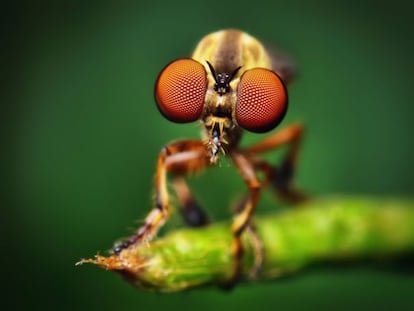How can we fight insects that can infect humans with diseases without harming the ones that do not?
A new method of pest control is only transmitted within the same species and has less environmental impact

Insects are part of the ecosystem and have beneficial effects. But there are some that can be very dangerous because of their nasty habit of acting as vectors of diseases like malaria or as agricultural pests like Xylella fastidiosa. Therefore, fighting certain types of insects can save lives directly or indirectly by preserving crops and preventing people from starving. Insecticides are our traditional way of defending ourselves against insects. But this approach presents several problems. For one, there is a lack of specificity. We may only be bothered by one species, but when we use insecticides we kill them all, so the ecological impact is much greater because we also kill beneficial insects. Another problem is that some of the insecticides that have been used were so-called forever chemicals, so they remain in the environment for a long time.
One way to avoid this serious environmental impact would be to specifically control the populations of the species that cause problems for us. That could be done chemically by releasing hormones into the environment that prevent them from reaching the adult stage, or pheromones that make them believe that a beautiful insect is ready to mate and waiting for them, when in fact they are falling into a death trap. However, the problem with these methods is that sometimes the necessary molecules are very expensive and are not always as specific as we would like them to be. A more effective strategy would be to radioactively sterilize a population of male insects. These males will copulate with females, but not produce offspring. This technique has been used for quite some time with reasonable results, although it is not 100% effective. But the use of radioactivity can also cause mutations, which could represent an improvement for the insect, and a headache for us, although that is unlikely.
However, genetic engineering can help. CRISPR/Cas9 is a technology that allows us to make a site-specific modification to any living organism’s genome. We can flip this approach on its head: instead of using this technique on an insect’s genome to make a specific change, we can transform an insect so that its genome contains everything necessary for CRISPR/Cas9 to be activated at a given moment and induce sterility. It would be like hiding a complete CRISPR/Cas9 kit in its genome, along with the instructions for modifying a particular gene to produce sterility. What is the advantage of doing that? If we simply disperse sterile males, those that are not sterile will continue to procreate (sterilization is never 100% and you have to compete with the native population), and in a few generations the effect will have disappeared.
It should be noted that a natural population has a Hardy-Weinberg equilibrium, which means that in the absence of external influences, different versions of the same gene are always present in the same proportion. If we were to release males with one copy of the gene mutated by traditional methods, the first generation with native females would give rise to healthy insects but with one copy of the mutated gene. Following Mendel’s laws, in the next generation, we would only manage to reduce 25% of the population, which would be those individuals that inherited the two copies of the mutated gene. But when we release insects transformed with the CRISPR/Cas9 kit, a technique called gene drive, into the environment, we ensure that the mutation is replicated in the genome and the Hardy-Weinberg equilibrium is broken, so the population decrease would be greater than 25% and would increase as the gene spreads in the following generations. The main advantage of this genetic modification is that it can only be transmitted within the same species and does not affect insects that cannot hybridize. That’s tailor-made pest control with the least environmental impact.
Malaria and chikungunya
There are currently several field trials using genetically engineered mosquitoes to evaluate this practice’s efficacy in pest control. These approaches are being tried for insect-borne diseases such as malaria, especially emerging diseases like Zika and chikungunya, which are diseases in poor countries where the necessary resources are not always invested.
Sign up for our weekly newsletter to get more English-language news coverage from EL PAÍS USA Edition
Tu suscripción se está usando en otro dispositivo
¿Quieres añadir otro usuario a tu suscripción?
Si continúas leyendo en este dispositivo, no se podrá leer en el otro.
FlechaTu suscripción se está usando en otro dispositivo y solo puedes acceder a EL PAÍS desde un dispositivo a la vez.
Si quieres compartir tu cuenta, cambia tu suscripción a la modalidad Premium, así podrás añadir otro usuario. Cada uno accederá con su propia cuenta de email, lo que os permitirá personalizar vuestra experiencia en EL PAÍS.
¿Tienes una suscripción de empresa? Accede aquí para contratar más cuentas.
En el caso de no saber quién está usando tu cuenta, te recomendamos cambiar tu contraseña aquí.
Si decides continuar compartiendo tu cuenta, este mensaje se mostrará en tu dispositivo y en el de la otra persona que está usando tu cuenta de forma indefinida, afectando a tu experiencia de lectura. Puedes consultar aquí los términos y condiciones de la suscripción digital.
More information
Últimas noticias
Most viewed
- Reinhard Genzel, Nobel laureate in physics: ‘One-minute videos will never give you the truth’
- Oona Chaplin: ‘I told James Cameron that I was living in a treehouse and starting a permaculture project with a friend’
- Pablo Escobar’s hippos: A serious environmental problem, 40 years on
- Charles Dubouloz, mountaineering star, retires at 36 with a farewell tour inspired by Walter Bonatti
- Why we lost the habit of sleeping in two segments and how that changed our sense of time









































